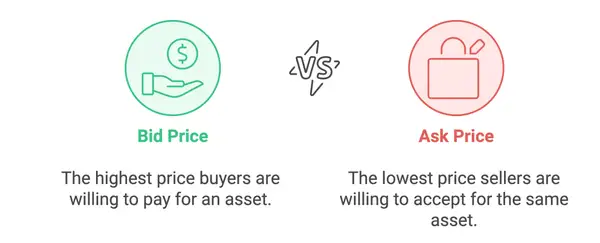Understanding the Spread in Crypto Trading

Spreads are a hidden cost that every crypto trader has to deal with, often cutting into potential profits without much notice. The difference between the buying and selling prices of an asset may seem small, but in volatile crypto markets, these costs can add up quickly.
At Morpher, we’re committed to making trading as accessible and fair as possible. While spreads are a natural part of trading, we’ve designed our platform to keep them transparent and reflective of real market conditions. Want to know how spreads affect your trades and how we’re helping traders navigate them? Let’s dive in.
What is Spread in Crypto?
In crypto trading, the spread is the difference between the bid price, which is the highest price buyers are willing to pay, and the ask price, which is the lowest price sellers are willing to accept. Simply put, it’s the gap between the buying and selling prices of an asset, and it represents the cost of executing a trade.
Spreads are a fundamental part of financial markets and serve a dual purpose:
- Compensating Liquidity Providers: Market makers (or platforms facilitating trades) set spreads to cover the risk of holding volatile assets while ensuring liquidity in the market.
- Reflecting Market Conditions: Spreads widen during high volatility or low liquidity, signaling traders about the current state of the market.
In crypto, where markets are more fragmented and volatile than traditional ones, spreads play an even more crucial role, often being the primary cost of trading.
How Do Spreads Impact Profit Margins?
Spreads have a direct impact on a trader’s profit margins by introducing an inherent cost to every trade. Whether you are opening or closing a position, the spread must be accounted for as it reduces your net gains. This cost is particularly noticeable for high-frequency traders or those handling large volumes, where even minimal spreads can add up to significant amounts.
Calculating the Spread in Crypto Trading
In crypto trading, the spread is the difference between two key prices: bid price and ask price.

The spread reflects the transaction cost of a trade and is calculated using the formula:
Spread = Ask Price – Bid Price
For a more precise understanding, spreads can also be expressed as a percentage of the ask price, which helps evaluate their relative impact on the trade:
Spread % = (Spread / Ask Price) × 100
Let’s break down how spreads work with Bitcoin trading to see their direct impact on a trader’s profits.
Suppose the current market prices for Bitcoin are as follows:
- Bid price (buying price): €99,000
- Ask price (selling price): €99,100
The spread is the difference between the ask and bid prices:
Spread = Ask price – Bid price = €99,100 – €99,000 = €100
1. Entering a Trade
You decide to buy 1 BTC. Since you’re buying, you’ll pay the ask price of €99,100 for the trade.
Immediately after purchasing, the value of your position is based on the bid price, which is €99,000. If you were to sell the BTC right away, you’d incur a loss equal to the spread:
Loss = Ask price – Bid price = €99,100 – €99,000 = €100
This means that Bitcoin’s price must increase by at least €100 for you to break even. Only after this point will you start seeing profits.
2. Exiting a Trade
Let’s say Bitcoin’s market price rises, and the new prices are:
- New Bid price: €100,000
- New Ask price: €100,100
If you sell 1 BTC at the new bid price of €100,000, your profit is calculated as:
Profit = New Bid price – Original Ask price = €100,000 – €99,100 = €900
Here, the spread has already been accounted for when you first entered the trade, which is why understanding and factoring in spreads is critical to accurate profit calculations.
Spreads are an unavoidable cost that affect your entry and exit points, especially in volatile markets like Bitcoin. At Morpher, we understand that this can be frustrating, which is why we offer zero-commission trading. This means you don’t have to worry about extra fees cutting into your profits. By focusing only on the spread, you can better manage your trades and keep things simple and cost-effective. Learn more about our zero commission policy here.
Why Are Spreads So High in Crypto?
Crypto markets are known for their higher spreads compared to traditional markets, and while that might seem like an obstacle, there’s a reason behind it. The crypto world is still growing and evolving, and with that comes a unique set of challenges.
Unlike the stock market, where there’s a long-established infrastructure and massive liquidity, crypto markets are newer, more fragmented, and highly volatile. That means the spread can shift rapidly depending on factors like market activity, asset liquidity, and even how much risk is involved.

How to Avoid Spread When Trading Crypto?
Unfortunately, there’s no way to completely avoid spreads when trading crypto. Spreads are an inherent part of the market, reflecting the difference between the buying and selling prices. However, there are a few strategies that can help you minimize their impact:
Trade During Stable Market Conditions: The spread tends to be narrower when the market is calm. Avoid trading during periods of high volatility, such as major news events or sharp price swings, when spreads are likely to widen.
Use Lower Leverage: Higher leverage increases the spread, as the platform adjusts for the increased risk. By using less leverage, you can keep spreads more manageable.
Monitor High Spread Warnings: On platforms like Morpher, you’ll get a warning if the spread exceeds certain thresholds, like 1%. By keeping an eye on these alerts, you can decide whether to wait for better conditions or proceed with caution.
While spreads can’t be completely avoided, these tactics can help you reduce their impact and optimize your trades.
Spread Betting? Not the Best Choice
Spread betting involves betting on the price movement of an asset without owning it, often using high leverage. It’s a highly speculative and risky approach, and while it might offer potential tax benefits in certain regions, the unpredictable nature of the market makes it a less reliable choice for many traders.
At Morpher, we focus on offering derivatives as a more transparent and secure way to trade. While spread betting involves betting on the price movement, derivatives are financial contracts that allow you to speculate on the price of an underlying asset, such as Bitcoin, without owning it directly. These contracts are tied to real-world market conditions and offer greater clarity in how they are structured, making them a safer option for traders compared to spread betting. If you would like to learn more about derivatives trading, visit our full guide.
Unlike spread betting, which can lead to highly unpredictable outcomes due to its speculative nature, trading derivatives on Morpher gives you access to real market pricing with zero commissions. We believe in providing a reliable, straightforward trading experience, where you can focus on the market itself without the complexities and risks of spread betting.
How to Handle Spreads on Morpher
While you can’t eliminate spreads, Morpher does its best to keep them transparent and consistent. Keep an eye on the High Spread Warning when trading, as this indicates when spreads exceed 1%. If you see this warning, it’s a good idea to assess the market before proceeding.
For your convenience, we also display how the spread is applied when entering or exiting a position. When you enter a new trade, the spread is added to the market price, and when closing a position, the spread is subtracted.
Why We Have Spreads?
Without spreads, traders could potentially exploit certain trading strategies that would not be viable in traditional financial markets, leading to unfair advantages and market distortions.
Here’s how it works:
In traditional markets, spreads are a natural barrier that prevents traders from taking advantage of tiny price discrepancies. For example, if spreads were eliminated, a trader could potentially execute a “buy low, sell high” strategy within seconds or even milliseconds, without any real change in the underlying market. This would allow traders to make a profit just from the price difference between the bid and ask, not based on actual market movement or the value of the asset.
In the real world, liquidity and spreads exist to prevent such practices. Spreads ensure that prices reflect the cost of executing a trade and help prevent market manipulation. On Morpher, we maintain spreads to reflect these real market conditions. This keeps the trading environment realistic and prevents such manipulation, ensuring that all trades are fair, based on actual market dynamics. This also maintains the integrity of the MPH token economy, where spreads play a role in keeping the system balanced and sustainable.
Conclusion: Spreads Are Part of the Game
The bottom line? While spreads are a natural part of trading and can’t be avoided, Morpher offers a fair and transparent way to navigate them. We don’t charge any trading fees, and our spreads reflect real market dynamics, ensuring you get the best possible pricing. With infinite liquidity and a system that helps maintain the stability of the MPH token economy, Morpher provides a reliable and sustainable platform for crypto trading.
So, while spreads are part of the game, Morpher is designed to help you trade smartly and confidently. Ready to start?
Trade with us today and see how we make crypto trading simpler and more transparent.
FAQ
What is spread in cryptocurrency trading?
In crypto trading, the spread is the difference between the bid price (what buyers are willing to pay) and the ask price (what sellers are willing to accept). It represents the transaction cost when buying or selling, and can have a significant impact on your profitability.
How does the spread affect profit margins?
The spread directly affects your profit margin. A wider spread means a larger portion of your profits will go towards covering the transaction cost, reducing your overall earnings. A narrower spread allows you to keep more of your profits, so minimizing the spread is key to optimizing your trades.
What factors influence the spread in crypto trading?
The spread is influenced by two main factors: market volatility and liquidity. Higher volatility typically leads to wider spreads, as market makers account for increased risk. On the other hand, cryptocurrencies with higher liquidity tend to have narrower spreads.
How can I minimize the spread in crypto trading?
While you can’t avoid the spread completely, you can minimize its impact by trading during periods of lower volatility or on highly liquid assets. Choosing a trading platform with competitive spreads, like Morpher, also helps keep costs manageable.
Ready to take your crypto trading to the next level?
Experience trading without the typical hassles of spreads and fees with Morpher. Enjoy zero trading fees, infinite liquidity, and full control over your investments, all while benefiting from features like fractional trading, short selling, and up to 10x leverage. Start today and see how Morpher can make crypto trading simpler, more transparent, and more profitable. Plus, a welcome bonus is waiting for you once you create your account!

Disclaimer: All investments involve risk, and the past performance of a security, industry, sector, market, financial product, trading strategy, or individual’s trading does not guarantee future results or returns. Investors are fully responsible for any investment decisions they make. Such decisions should be based solely on an evaluation of their financial circumstances, investment objectives, risk tolerance, and liquidity needs. This post does not constitute investment advice.

Painless trading for everyone
Hundreds of markets all in one place - Apple, Bitcoin, Gold, Watches, NFTs, Sneakers and so much more.

Painless trading for everyone
Hundreds of markets all in one place - Apple, Bitcoin, Gold, Watches, NFTs, Sneakers and so much more.









